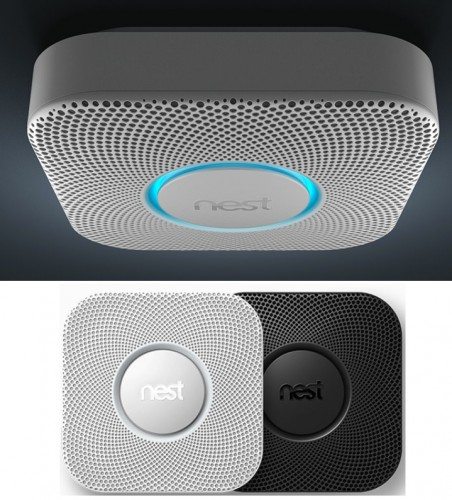The Nest Protect, from the makers of the Nest Thermostat, aims to change the way your home smoke alarm works. The Protect monitors smoke, heat, and carbon monoxide levels in your home. It’s smart about how it alerts you to possible emergency conditions, too. You tell the Protect what room it’s in, so a human voice can alert you with a “Heads up. There’s smoke in the kitchen.” and a yellow light as an early warning before beginning to blare an alarm. Because the Protect has a motion detector, you can simply wave your hand under it to stop the klaxons before they begin if you’ve simply burned the toast. If conditions warrant, you’ll see a red light on the Protect and hear “Emergency. There’s smoke in the kitchen.” If you have multiple Protect monitors, they can all speak so you’ll hear the warning for the bedroom even when you are in the living room. If you also have a Nest Thermostat, it will turn off the gas furnace when the Protect detects elevated levels of carbon monoxide in your home. With the Android or iOS app, you can receive alerts and interact with your WiFi-connected Protect from anywhere. The Protect also acts as emergency lighting; it will turn on a light when it senses motion.
Protect is available in black or white and in wired or battery-powered versions for $129. You can pre-order the Protect now at the Nest website, or you can sign up to be notified when the Protect is available.




Gadgeteer Comment Policy - Please read before commenting
It is a cool device. The only thing we could not find was how they could get the CO and smoke detector to work together.
CO is heavier than air…so we always thought it should be placed low, but smoke rises…which is why it is place at the ceiling.
So where does one place this combo unit?
Would love to own this, but it would cost me over a grand to outfit my house. I’ll stick with the $30 detectors to the banker guy from Monopoly.
Excellent question, RainyDayIntern!
Oops, and leave this to the banker guy from Monopoly.
@RainyDayInterns: CO2 is heavier than air. CO is basically the same average molecular weight as air, so it should disperse the same as N2. (It’s actually lighter than O2…)
And of course this only really matters in still, static air. All of these are within a few percent of each other in weight, so if the air is being moving at all (like it is most everywhere) it will quickly disperse. The settling thing with CO2 that people worry about is only really relevant to caves (where air sits still for very long times) and when you are using dry ice (Which releases a large amount of CO2 quickly, and usually close to the ground. It’s also colder than the surrounding air, making it more likely to settle.).
But yeah, they are expensive. I can see one upstairs with a Nest downstairs – basically trying to get full-house coverage for the Nest activity sensor – but actually putting one in each room would quickly add up. I want to know how well they work with existing three-wire installs, when you *aren’t* replacing every detector with them.
Pre-ordered one. If you already have a nest it’s pretty much automatic. My Nest has saved me easily 15% or more over even my previous programmable thermostat. My house only has one detector (small house) but I can see where putting them in a large house would be expensive. However, I wouldn’t think that you would have to replace all your detectors with them. If I burn toast my current detector goes off. The wave to ignore feature alone is worth the price of admission for me.
Thanks DStaal! We were misinformed and are always happy to be corrected 🙂 The combo-detector now makes a lot of sense.
Maybe I’ll get one.